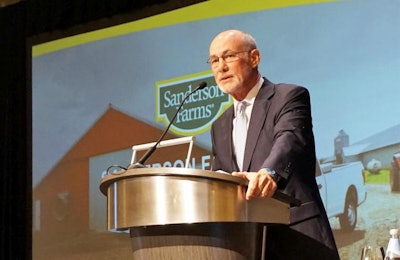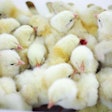
Sanderson Farms Inc. is doing things differently than the rest of the industry because it sees the world differently.
On July 23, 2018, Lampkin Butts, the president and chief operating officer of the Laurel, Mississippi, integrator, gave the keynote speech at WATT Global Media’s Chicken Marketing Summit (CMS) 2018 in Orlando, Florida. He focused on the potential for market disruption in the chicken industry as well as his company's unique marketing strategy.
“It’s going to take all of us to meet consumer preference and demand and we have taken a different marketing position,” Butts told an audience of chicken industry members. “Honestly, sometimes we feel like we’re swimming upstream, but we believe we’re doing the right thing.”
A new disruption?
In 2018, the domestic poultry industry is rapidly expanding its production capabilities. This continues a hot run for the industry as well as Sanderson Farms. Butts said the company maintained profitability each year since 2012. Those profits enabled the company to build three new complexes – ranging in cost from $160 million to $225 million – without taking on any new debt.
Sanderson Farms believes profits are incentivizing growth in the industry and will continue to do so until 2022. As new complexes are announced and come online, more product will come onto the market. This potentially represents a significant increase over historical growth levels in the industry.
Butts said seven companies, including Sanderson Farms, are currently working on new poultry facilities. Once completed and running at capacity, they will add more than 11 million head per week to industry capacity. That’s an 8 percent increase in live pounds produced in the next four to five years above any increases due to elevated slaughter volumes at existing plants.
This forces the question of how the market will absorb all the new product and at what price. It also potentially represents another period of disruption.
Butts said disruption is inherent to the industry. He recounted four major industry disruptions since 2000: The Russian embargo in 2002; avian influenza in 2006; the recession of 2008 and drought, high grain prices and oversupply in 2011.
At this point, dealing with disruption is just part of doing business. However, no one really knows what’s going to happen when that new product hits the market.
Sanderson Farms, he said, believes the new production will be absorbed at profitable prices if the following exists:
- Low grain prices
- Excellent export demand
- Continued excellent demand for fresh chicken at retail grocery stores
- A stronger gross domestic product and a return to normal food service demand
Butts said demand at grocery continues to be excellent and four of the seven new plants coming on line in the industry will be producing product for retail grocery stores.
Seeing the world differently
Butts said Sanderson sees the world differently than others the industry. That vision manifests itself in how the company conducts business and expresses itself.
While other broiler companies are growing through acquisition, Sanderson is building new complexes. Sanderson is the third largest chicken company in the U.S. According to WATT Global Media’s annual Top Broiler Companies survey, the company produced 82.5 million pounds of ready-to-cook chicken on a weekly basis in 2017.
Since 1993, Sanderson’s growth occurred by building new complexes including hatcheries, feed mills and processing plants. It has built seven new plants and is on the way to opening its next one in Tyler, Texas, in 2019. In that same time period, only one other new complex was built by a company other than Sanderson, Butts said.
Sanderson also sees antibiotic use differently. The chicken industry is facing a watershed moment as more companies embrace antibiotic-free (ABF) and no antibiotics ever (NAE) husbandry practices. Butts said Sanderson is not blind to the wave of companies making pledges. However, when the trend began in 2015, with Chick-fil-A’s announcement followed by others like McDonald's and Subway, Sanderson began researching whether there is any credible, proven scientific data linking Sanderson Farm’s antibiotics use to the development of antibiotic-resistance in humans.
“There are many theories out there, there’s research but there’s no proven link that ties antibiotic usage in poultry production to antibiotic resistance in humans,” Butts said. “The antibiotics we use are FDA approved as safe and healthy and are only used as prescribed by one of our veterinarians.”
Sanderson uses antibiotics judiciously, Butts said, and only to prevent and treat disease. If a link between its antibiotic use and the development of antimicrobial resistance in humans is ever discovered, then Sanderson will change its entire process immediately.
Truth telling
Sanderson is also gaining attention for its use of punchy advertising addressing what it calls marketing gimmicks used in the industry. Butts said this strategy is informed by the truth about consumers. Shoppers care about price, freshness, taste, quality and food safety when purchasing fresh chicken. Only a small minority will make a purchasing decision based on label claims dealing with topics like antibiotics, hormones, steroids or being raised locally, cage-free or free-range.
Butts said consumer research demonstrates 80 percent of consumers will listen to the facts, think logically and are willing to keep an open mind and learn more about their food. Sanderson wants to target this majority to reach and engage them with the right message.
In late 2016, Sanderson launched an advertising campaign aimed at taking on labeling issues involving antibiotics, hormones, steroids and other topics it calls marketing gimmicks in the poultry industry. Butts said ads started airing in the third quarter of 2016 and are shown on television, radio and digital channels in Sanderson’s distribution area around the country. Sanderson is following how these ads are received, too. Butts said the company’s consumer research shows people like the material and are engaging with the brand because they appreciate the transparency of the message. Overall, the campaign is rated more than 75 percent favorable.
“We believe if we continue to remain transparent and tell our customers and consumers more about why we do what we do and how we do it, they will not only have a better understanding of poultry production, but they will also be able to feel better about what they are buying and feeding their families,” Butts said.
Join us in 2019
The 2018 Chicken Marketing Summit was hosted July 22-24 at the Four Seasons Resort Orlando at Walt Disney World. Included in the record attendance at the 2018 Summit were attendees from 11 countries. The 2019 Chicken Marketing Summit will be held July 21-23, 2019, at the Belmond Charleston Place Hotel in Charleston, South Carolina.


















